Table of Contents
Introduction
EasyCall turns a mobile phone into an easy-to-use phone and alarm device for elderly, visually impaired, handicapped, sick, very young children etc.
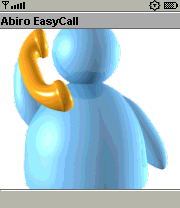 |
Any number of actions and times can be configured.
An action can be used to:
- issue a call to a set number
- send a text message via SMS to a set number and with a set message
- send a photo via MMS to a set number and with a set message
What can actually be achieved depends on the features of the phone.
Scheduled times can be used to alert the user of important things to take care of or be aware of. A text description tells the user what the scheduled event is about.
Main Screen
The screen displayed directly after start of EasyCall shows the configured actions that a user performs by choosing one of them and pressing Perform.
This is the only screen that the actual end-user needs to work with. The rest can be configured by someone else.
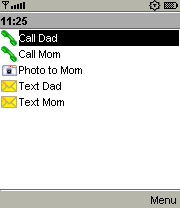 | 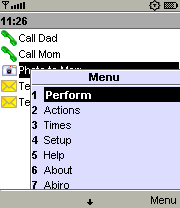 |
Scheduled times are shown as popup dialogs, that are closed by selecting Close. Such dialogs are stacked, so you won’t miss any scheduled events.
The current time (hour and minute) is also shown at the top of the screen, for reference.
Some of the commands described below and on other screens might be shown on soft keys, depending on phone. The other commands will be shown in a menu, typically accessed via ‘More’, and in the order given in the descriptions.
Commands on the main screen
- Perform – performs the selected action
- Actions – configures actions
- Times – configues scheduled times
- Setup – configures alert types, duration and camera resolution
- Help – this help information
- About – provides information about EasyCall
- Abiro – goes to Abiro’s mobile site
- Exit – exits EasyCall
Actions
To configure actions, choose Actions in the menu. The list of already configured actions (the same as on the main screen) is then shown. From here you can add, edit and delete actions. Actions are sorted alphabetically on Description.
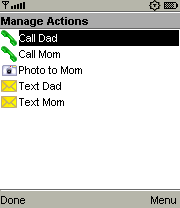 |  | 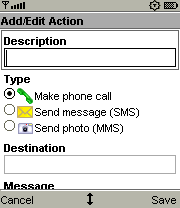 |
Commands on the Manage Actions screen
- Add – adds a new action
- Edit – edits an existing action
- Delete – deletes an existing action
- Done – exits Manage Actions
Contents on the Add and Edit screens
- Description – will be shown in the action list on the main screen
- Type – what should happen when an action is performed
- Make phone call
- Send message (SMS)
- Send photo (MMS)
- Destination – indicates what number to call or send to
- Message – text message for SMS and MMS
Commands on the Add and Edit screens
- Save – saves the new settings
- Cancel – leaves without saving new settings; previous settings are kept
Times
Choosing Times on the main screen opens the Manage Times screen. Here you can set up any number of scheduled times. Times are sorted alphabetically on Description.
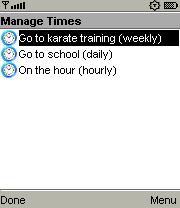 |  |  |
Commands on the Manage Times screen
- Add – adds a new time
- Edit – edits an existing time
- Delete – deletes an existing time
- Done – exits Manage Times
Contents on the Add and Edit screens
- Description – a description of the scheduled time that will be shown in the Manage Times list and to the user when the time expires
- Interval – sets how often the set time will expire
- once
- hourly
- daily
- weekly
- monthly
- yearly
- Date and time – the scheduled date and time
Commands on the Add and Edit screens
- Save – saves the new settings
- Cancel – leaves without saving new settings; previous settings are kept
Notes
- Even though a complete date and time is always set, only relevant time elements are used depending on the set interval. E.g. if set to hourly, the date and hour doesn’t matter. The scheduledtime will expire at the set minute every hour. The same approach is used for the other intervals.
- ‘weekly’ means real weeks over the year. The set date and time in that case indicates the week day and time this time will expire, and then 7 days later, 14 days later etc.
- The time resolution is minutes.
Setup
Configures global settings for EasyCall.
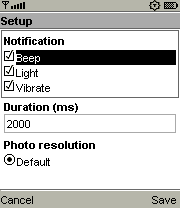 |
Contents
- Notification – sets what kind of notification will be issued when a scheduled time expires
- Beep – sounds a beep
- Light – turns on the backlight
- Vibrate – vibrates the phone
- Duration – sets the duration of the notifications
- Photo resolution – sets the resolution of the photos taken by the camera (if such exists)
Commands
- Save – saves the new settings
- Cancel – leaves without saving new settings; previous settings are kept
Advice
- Use capital letters in activity and time descriptions for greater readability
- Set a longer notification duration in Seup if there’s a risk they won’tget noticed. Also, activate more notification types for the same reason
- Keep the list of actions short, so all actions are visible at oncewithout scrolling
- The action and time lists are sorted ASCII-alphabetically, so you canadd e.g. “.” to the beginning of a description to make it appear first inthe list, whatever the actual description
Compatibility
EasyCall should be compatible with any phone supporting CLDC 1.0 and MIDP 2.0, and optionally SMS, MMS and photography.